What to do if the hood in the bathroom and toilet works poorly: causes of the problem and methods for solving it
When designing houses, the mandatory presence of ventilation in the utility rooms, the kitchen, and of course in the bathroom and toilet, is taken into account. This is necessary to ensure natural air exchange in these rooms.
As for the bathroom and the toilet, it is thanks to the ventilation that the normal humidity of the air is maintained, timely evacuation of the exhaust air and its replacement with clean air.
If the hood in the bathroom and toilet does not work well, stagnation of air is inevitable, which in the near future will result in the appearance of mold and mildew, and also adversely affect the decoration of these rooms. Extremely unpleasant situation, isn't it? But what to do in this case and how to prevent it?
In this article we will talk about the causes of problems with ventilation in the bathroom and toilet, and also we will analyze the best ways to solve them.
The content of the article:
How is the ventilation of the bathroom and toilet?
Ventilation is, first of all, a whole system consisting of air channels and mines. When designing it in private or an apartment building, stable performance is calculated with proper operation.
The ventilation device includes:
- Ventilation duct (ventilation shaft), which is a combination of solid direct air channels and vertical shafts. The shaft and channel can be either round or square. A prerequisite for stable air movement is their purity and integrity. There are also horizontal ventilation ducts, but their length should not exceed two meters, otherwise the air movement will become difficult.
- Ventilation outlet - This is a hole in the wall of the bathroom or toilet, which is connected to the ventilation duct.The size of the opening of the ventilation outlet does not necessarily correspond to the cross section of the channel and is calculated based on the creation of the throughput of the maximum possible air volume.
- Ventilation grill - it is necessary to protect the ventilation duct from the entry of debris into it, as well as from the possible penetration of insects and rodents into the room. It is made of plastic or metal. It has a decorative appearance, since its front part should fit into the interior of the room.
It is worth noting that ventilation can be naturallyth and forced. The difference lies in the use of additional devices to mechanically create more traction.
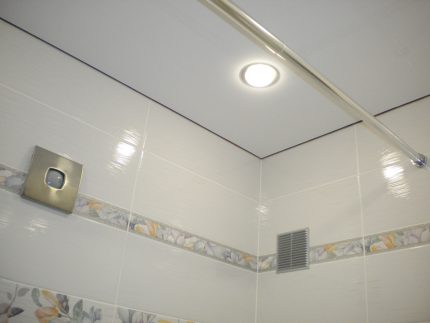
Additional devices are installed in cases where due to natural draft effective ventilation of the room is not provided.
Features in the operation of ventilation systems
The ventilation of the premises of apartment buildings and private sector houses can be ensured by the proper arrangement of natural and forced ventilation. Consider these two types of system in more detail.
View # 1 - Natural Ventilation
Natural - this is ventilation made in accordance with general standards. It is used in all typical apartment buildings.
The principle of operation is based on the law of convection, the essence of which is that due to the difference between indoor temperature and outdoor temperature, as well as because of the difference in pressure, which is different on the street and indoor, air is independently drawn into the ventilation duct.
The force with which air flows into the channel is called draft. The air that has gone into the ventilation frees up space for fresh air.
View # 2 - forced ventilation
The main difference between forced ventilation, as mentioned above, is that additional equipment is used, namely, household fans various types (axial, channel or radial).
The principle of operation is based on additional traction reinforcement due to the rotation of the blades of these devices. Equipment ventilation is carried out independently.
Forced ventilation in most cases is an independent improvement of the natural. It must be carried out in compliance with the standards (in particular, according to the fan power), otherwise such a installation may violate the natural ventilation system of the room in an apartment building.
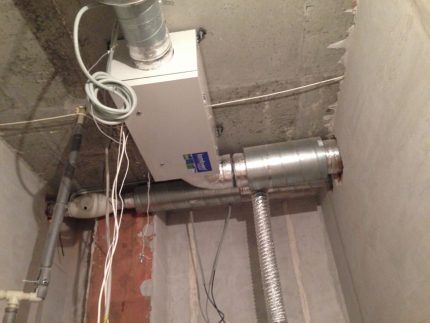
Depending on the functions performed, forced ventilation is:
- exhaustwhen the air flow is drawn by a fan into the street;
- supplywhen the fan, on the contrary, delivers air to the room, and the full ventilation cycle is ensured by air leaving naturally through the shafts and ventilation ducts;
- supply and exhaustwhen there is the possibility of both forced injection of air into the room, and its removal from it.
The existing forced-air ventilation is used for volumetric rooms, when the natural mutually regulated air movement in the room is not enough.
What ventilation is needed in the bathroom and toilet?
According to the designers, natural ventilation should cope with air circulation independently. However, the normal circulation of indoor air by natural ventilation is often not ensured.
This happens for three reasons:
- during natural ventilation, a constant flow of external air into the room must be ensured - the door must be open, a special internal window installed wall inlet valve;
- contamination of the inner walls of the ventilation ducts occurs - dust, dirt, debris and cobwebs appear in the ventilation over time and in the absence of cleaning;
- clogged external ventilation outlets.
Thus, for the organization of effective ventilation of the toilet and the bathroom, it is more advisable to use forced ventilation. It will provide a quick change of air in the room, in the shortest possible time will remove odors and reduce humidity.
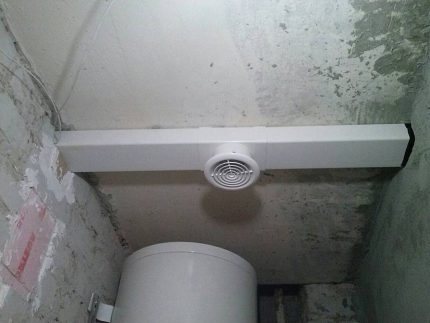
It is worth noting that to determine the state of ventilation it is enough to use a sheet of paper or a lit match brought to the ventilation grill. With the optimal operation of the ventilation system, the flame should deviate significantly towards the channel, and the sheet of paper should be attracted to the grate.
If this does not happen, then we can talk about a problem with ventilation. One reason for insufficient traction is the lack or weak air flow. What may be a consequence of the tightness of the doors installed in the bathroom / toilet. Such an obstacle to the supply of fresh air is the reason that the exhausted moist air cannot be pulled out of the room even with a properly working hood and with the fan turned on.
When choosing and installing exhaust devices, you must be guided by the main guidelines: SNiP 41-01-2003 (“Heating, Ventilation and Air Conditioning”) and SNiP 2.08.01-89 * (“Residential buildings”), which are updated as of 2019 as a result of certain changes. In particular, an air exchange of at least 25 cubic meters per hour should be provided in the bathroom and toilet. If the bathroom is combined, then at least 50 cubic meters per hour.
Causes of hood performance
Poor operation of exhaust ventilation cannot be caused only by contamination of ventilation ducts and outlets or the creation of an artificial obstacle to the occurrence of draft.
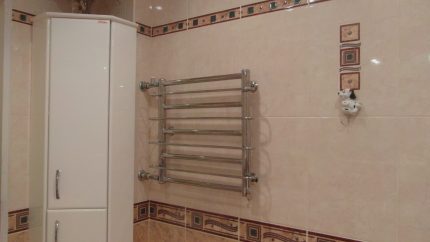
There are a number of reasons why the hood in the toilet and / or bathroom stops working.
Among them are the following:
- High outdoor temperature. Air circulation more efficiently occurs during periods of the year when the temperature outside the window drops below +5 degrees.
- Axial fan installation. Due to the design features in the off state, this type of fan interferes with the free penetration of air. The motor and the axial fan blades do not move without electric current.
- Excessive exhaust hoods. Using too powerful a fan will lead to disruption of the designed air movement throughout the ventilation system. As a result, the dispersed air does not go out into the street, but enters other premises of the apartment building.
- Redevelopment and illegal interference in the general ventilation system. As a result of the changes made, the tightness of the ventilation system may be impaired or one of the channels may be blocked. That is why any redevelopment requires coordination with government agencies.
- Incorrect installation of the bathroom door or toilet. Typically, a problem occurs when there are no special ventilation openings in the door leaf (typical for cheap doors) and there is no gap between the floor and the door.
- Appearance reverse thrust. This problem is typical for the upper floors of apartment buildings due to the appearance of excessive pressure in the ventilation system.
When one of the reasons that affect the normal circulation of air appears, the humidity in the bathroom and toilet immediately rises.
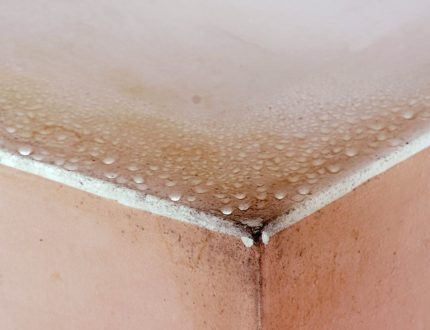
By the way, condensate not only signals about ventilation problems, but can also cause damage to ventilation equipment. For example, as a result improper installation of additional equipment a gap forms between the fan and the draft ceiling of the ventilation system. Due to the cooling of hot air, condensation forms in this gap, which is partially absorbed and partially flows down. Condensation may cause fan failure over time.
We also recommend that you familiarize yourself with the reasons why the hood may don't work at all, as well as ways to eliminate them.
Methods for determining exhaust malfunction
The bathroom should not have poor ventilation. Indeed, otherwise the level of humidity increases, which is an indicator environmental condition of the premises. Fresh air can cause people to feel worse, feel stuffy and heavier, and also cause exacerbation of chronic diseases.
That is why there is the concept of optimal and permissible humidity in the room, which is indicated in GOST 30494-2011. For the bathroom, the optimal values are 30-45%, permissible - up to 60%.
It is possible to prevent an increase in the humidity level to critical values if a failure of the hood is timely detected and eliminated. Therefore, if you began to notice that after visiting the bathroom, moisture remains on the walls and mirrors for too long, it is advisable to check the traction. Why you can use a sheet of paper (lean it against the ventilation grill) or a lit match (the flame will deviate towards the grille), which will determine the strength of the exhaust air flow. If it turns out to be too weak, you should call the representative of the management company.
A specialist with the help of a special air speed meter - anemometer will measure the air outflow rate per hour and give an opinion on the non-compliance with the standards. He can also determine air permeability for the entire riser of an apartment building.


It is worth noting that a communal specialist may not determine the problem if it is associated with the use of a too powerful fan by a neighbor - during the study of the traction force in the system, the exhaust device may be turned off.
In winter, you can also check the hood in the bathroom and toilet yourself. To do this, open the window and doors of the room where the ventilation outlet is located. This will allow you to disperse the exhaust draft due to the displacement of warm air cold. It is enough to attach a sheet of paper to the exhaust grill. With a working ventilation system, it should stick to the grill.
Best Solutions
Now let's talk about what to do if the hood in the toilet or bath does not work. So, the standard and most effective way to solve the problem associated with a ventilation malfunction is to contact the management company, which must take effective measures to restore the hood to normal operation. Their responsibilities include verification, cleaning and restoration of ventilation ducts.
They are also obliged to force the residents of the apartment building, who themselves during the redevelopment, dismantled or changed the ventilation ducts, to restore their original condition.

However, engaging a management company is a rather lengthy process.
Therefore, some problems can be solved independently:
- If there is a problem with the “back draft” effect when the air from the hood enters the room, then it can be solved in two ways: either by installing a blower fan that makes the air pressure in the room stronger, or by mounting a decorative grille with check valve into a standard exhaust hole, which will recreate an obstacle for air to enter the room from the exhaust system.
- Improving the operation of the hood on the upper floors of an apartment building will help increase the height of the duct, which ends the ventilation duct. It is located on the roof of the house and you can increase its length yourself using a corrugated pipe. You can also install deflector, which under the influence of wind will create additional traction in the system.
- The problem with the hood in a private house can be solved by installing a separate duct. It will give an additional flow of air and, therefore, increase the pressure in the room, which will create a process of air circulation. The vertical channel with access to the roof will work most effectively.
- When the hood does not work in one of the rooms, the problem is solved fan installation. Only this installation must be carried out in strict accordance with regulatory requirements in order to avoid consequences. Currently, you can buy fans equipped with a humidity sensor, a time switch and a motion sensor, which allows them to be used most efficiently, while maintaining energy.
It is worth paying attention to the cleanliness of the decorative ventilation grill. There are cases of dusting a special mesh, which is necessary to prevent insects from entering the apartment, as a result of which air cannot normally escape into the ventilation duct.
Also need regular clean fan in the bathroom and toilet, taking into account the manufacturer's recommendations for caring for a particular model.
Conclusions and useful video on the topic
The principle of natural ventilation is shown in detail in this video:
In order to make it more clear how you can do the cleaning of the ventilation shaft with your own hands, you can watch this video:
This video shows why and how to install additional devices for forced ventilation of the bathroom:
The proper operation of the hood in the bathroom and in the toilet is the first and foremost guarantee of the health of residents of an apartment or house. The absence of humidity, dampness and mold, the regulation of the freshness of the air in the room depends on the operation of the hood. Dampness negatively affects the interior decoration of rooms and can lead to destruction of tiles and the formation of rust on metal surfaces.
If problems with the normal operation of the hood are identified, immediate measures should be taken to rectify the situation, and if you cannot solve it yourself, then you need to contact the management company for help.
Do you have questions, useful additions, or want to share your personal experience in troubleshooting a ventilation system in a bathroom? You can leave your recommendations and other information as a comment on the article in a special form, which is located below.

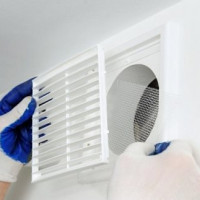 What to do if the ventilation in the apartment and the house does not work? Overview of possible causes and solutions
What to do if the ventilation in the apartment and the house does not work? Overview of possible causes and solutions 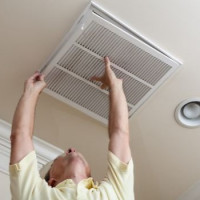 Repair of ventilation in the toilet and bathroom: how to identify and repair the hood in the bathroom yourself
Repair of ventilation in the toilet and bathroom: how to identify and repair the hood in the bathroom yourself  How the exhaust hood with recirculation works + typical ventilation schemes with air recirculation
How the exhaust hood with recirculation works + typical ventilation schemes with air recirculation 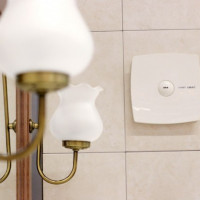 How to disassemble the exhaust fan in the bathroom: instructions for disassembling and cleaning the exhaust fan
How to disassemble the exhaust fan in the bathroom: instructions for disassembling and cleaning the exhaust fan 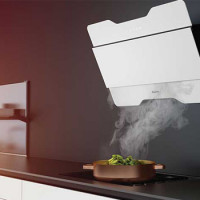 Coal hood: types, device, selection and installation rules
Coal hood: types, device, selection and installation rules 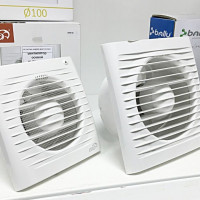 TOP-10 rating of silent fans for a bathroom with a non-return valve
TOP-10 rating of silent fans for a bathroom with a non-return valve  How much does it cost to connect gas to a private house: the price of organizing gas supply
How much does it cost to connect gas to a private house: the price of organizing gas supply  The best washing machines with dryer: model rating and customer tips
The best washing machines with dryer: model rating and customer tips  What is the color temperature of light and the nuances of choosing the temperature of the lamps to suit your needs
What is the color temperature of light and the nuances of choosing the temperature of the lamps to suit your needs  Replacement of a geyser in an apartment: replacement paperwork + basic norms and requirements
Replacement of a geyser in an apartment: replacement paperwork + basic norms and requirements